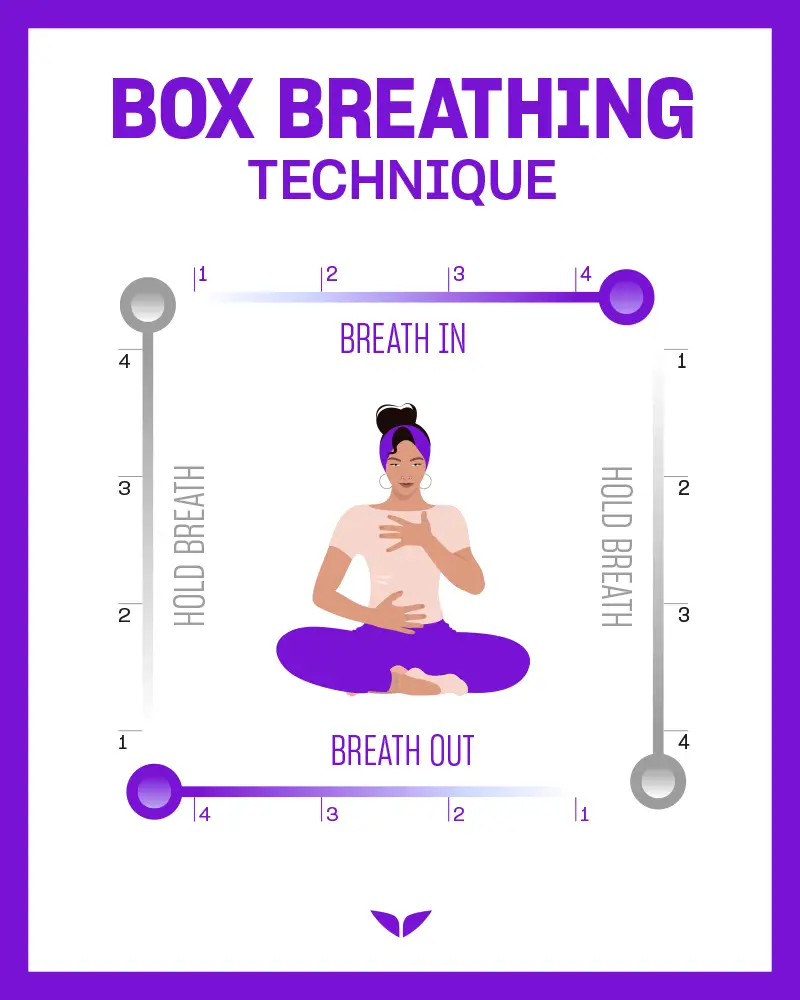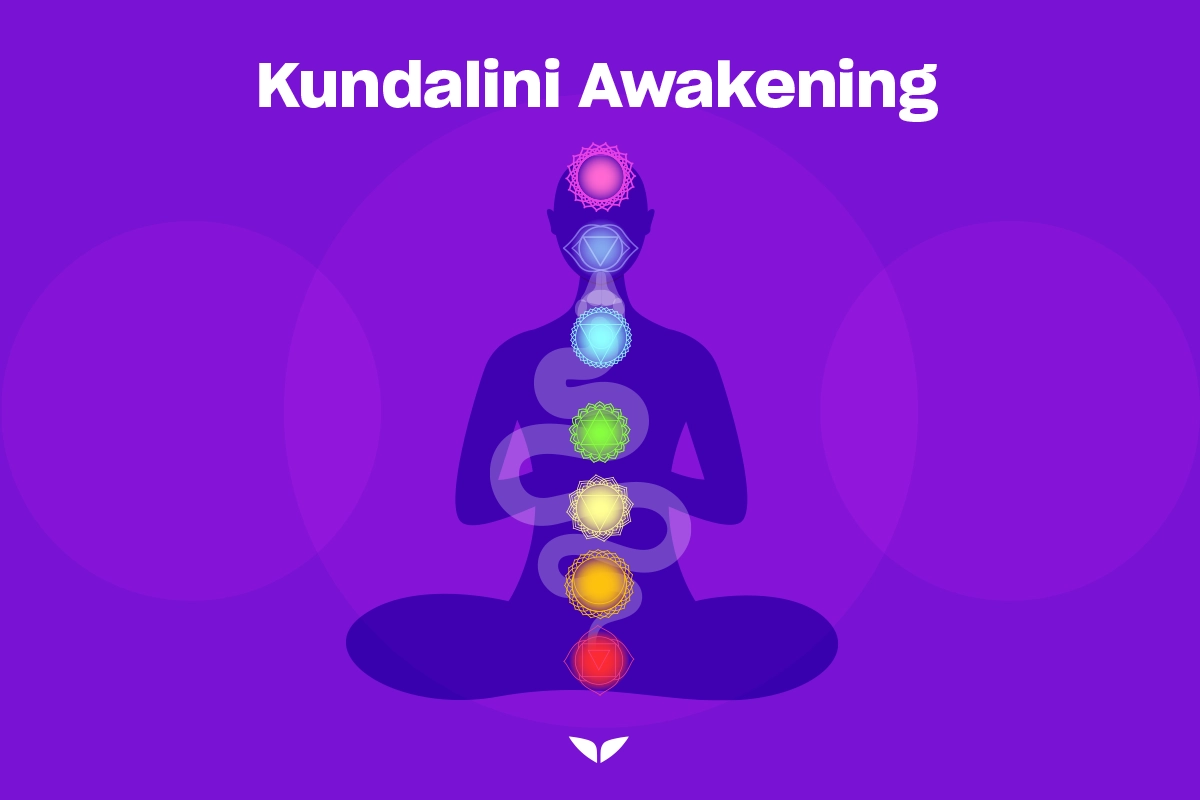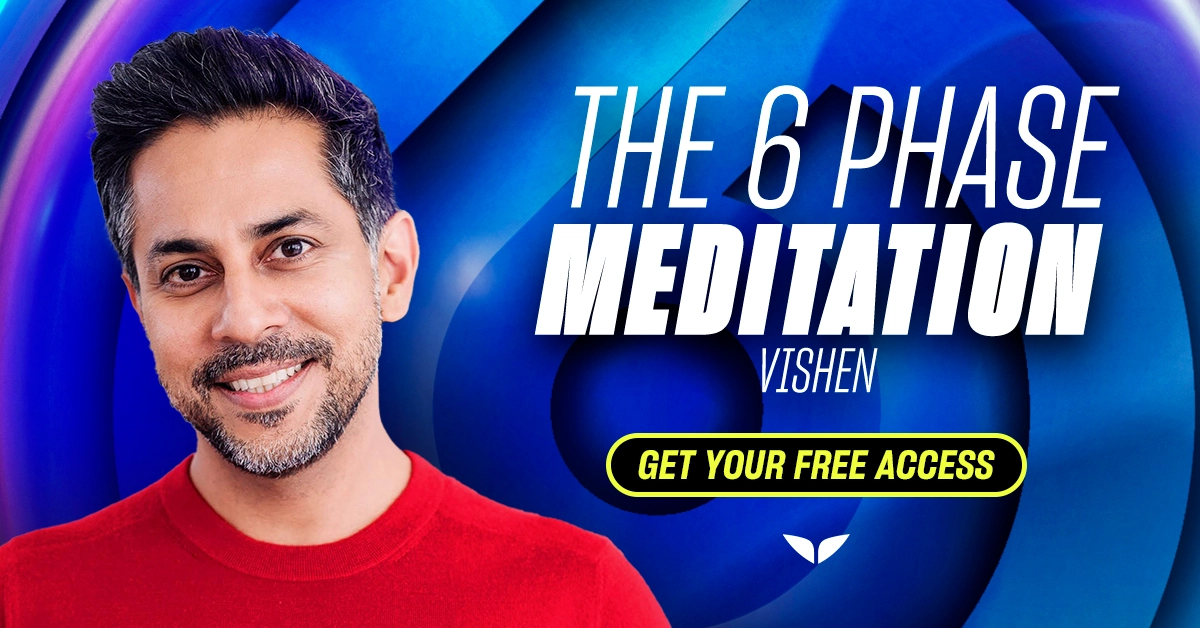Meditation. Just the word might conjure images of monks on mountaintops.
But in reality, it isn’t some exclusive ritual for a select few; it’s a practice that’s both accessible and profoundly transformative for all. For centuries, it’s been a way to calm the mind and even heal the body, with science supporting its various benefits.
What’s even more awesome? You don’t need a guru or a Himalayan retreat to tap into its power. All you really need are the right meditation techniques for you to get started.
Some are straightforward, while others might take a little more effort to master. But most are easy to learn, even if you’re new to the practice.
How many meditation techniques are there?
Believe it or not, there are thousands and thousands of meditation techniques practiced around the world. Many are taken straight from Buddhist and Hindu traditions, while others draw on modern wellness practices such as mindfulness and breathwork.
But despite this versatility, people tend to think of meditation as one thing:
Sitting cross-legged in a lotus position…
Spine perfectly straight…
Breathing on cue…
And that’s it.
The thing is, that’s not all there is to it, says Vishen, the founder and CEO of Mindvalley. What we often envision as the go-to meditation approach is, in fact, what he says is “hermetic meditation.” It’s a style that dates back to ancient China and India, yet it’s only one of many.
“Back then, you didn’t have WhatsApp messages to answer, a 9-to-5 job, or kids to get off to school,” he says in his 6 Phase Meditation program on Mindvalley. “People could sit under a banyan tree and meditate for hours. But in today’s world, that’s just not practical.”
So, whenever you wonder, “What are some meditation techniques out there that are good for me?” Just remember Vishen’s wisdom: meditation is never meant to look just one way. It was always meant to work in the life you’re actually living.
The universality of meditation
The goal of meditation, in the end, is to help you reach powerful states of peace and positivity, even if you only have minutes to spare each day. And here’s where modern techniques come in, making a case for the practice’s flexibility and diversity.
Jon Kabat-Zinn, a scientist known for introducing mindfulness into modern clinical settings, is quick to frame it as a universally flexible practice. After all, mindfulness transcends culture. “Mindfulness,” he writes in his book, Wherever You Go, Wherever You Are, “means paying attention in a particular way: on purpose, in the present moment, and nonjudgmentally.”
And the way meditation makes you feel is the end goal here.
According to a 2014 study published in the Journal of the American Medical Association, it reduces cortisol levels and eases physical symptoms of tension. Another one published in Clinical Psychology Review reveals that the practice, as a mindfulness-based intervention, can help individuals process emotions more effectively.
So the mind–body benefits are real here. And while they can sound almost outsized for something so simple, they are what neuroscientist and bestselling author Dr. Joe Dispenza calls a trainable state. In his critically acclaimed book, Breaking the Habit of Being Yourself, he writes, “Meditation is not about getting rid of thoughts, but about becoming aware of them and choosing not to follow them.”
So, no matter which technique you fancy, one thing’s for sure: you get to decide how you want to meditate and when you’d like to feel good with it.
5 best meditation techniques for beginners
Getting started with meditation can be intimidating at first. To choose the right mindfulness meditation techniques, check first if it’s:
- Accessible,
- Straightforward to perform, and
- Easy to fit into your daily routine.
Research published in Ayu (an international quarterly journal of research in Ayurveda) shows that beginners tend to give up more if they find techniques too complex to commit to. So, when in doubt, go simple.
Below are some easy ones that may be up your alley.
1. Mindfulness meditation
Mindfulness meditation is meditation at its simplest, and it’s often the gateway for many beginners. It’s all about being present as is, so you can train your attention to stay with one experience at a time—often the breath—without trying to change your incoming thoughts.
Like Tibetan Buddhist monk Pema Chödrön would say, “Meditation practice isn’t about trying to throw ourselves away and become something better. It’s about befriending who we are.”
So, by embracing mindfulness through meditation, you get to return to yourself.
Is this right for you?
If you’re someone who’s constantly juggling thoughts and trying to find a moment to breathe, mindfulness is your friend. It’s gentle, requires no unique setup, and is perfect if you’re looking to manage stress or curb overthinking.
How to do it:
- Find a quiet spot, sit comfortably, and close your eyes.
- Breathe naturally, focusing on the sensation of your breath.
- When your mind wanders (because it will), just bring it back to your breath.
- Start with five minutes, and work up from there.
Get more from this guided experience:
2. Loving-kindness meditation
Loving-kindness meditation, also known as Metta meditation, gets you radiating good vibes outward. You start by sending love to yourself, then extending thoughts of goodwill and compassion to others to kickstart a possible ripple effect.
Its effects are well-documented. A randomized controlled trial published in Psychological Science found that this type of meditation, done briefly every day, can increase your positive emotions and strengthen your sense of connection to others.
And what makes it fun? Well, you get to creatively visualize anything that represents love while you’re at it. Vishen, who swears by this approach, says, “Simply doing this changes your heart resonance to a healthier, more beneficial level for your well-being.”
He’s onto something. A 2024 study in The Journal of Affective Disorders Reports shows that compassion-based interventions like this meditation can increase your heart rate variability, a marker of parasympathetic nervous system response.
Is this right for you?
If you’re dealing with negative self-talk or looking to build a more compassionate outlook about life and others, then this technique fits the bill. Think of it as a gentle, heart-centered mood booster, if you will.
How to do it:
- Sit comfortably and close your eyes.
- Start saying positive affirmations to yourself, such as “May I be happy,” “May I be healthy,” and “May I be at peace.”
- Then, extend these wishes to others, from loved ones to acquaintances, through statements like “May the people in my life have good health” and “I send love and peace to all of mankind.”
3. Walking meditation
Sometimes the simplest way to slow the mind is to let the body keep moving. Walking meditation, for one, combines movement with mindfulness to habitualize self-awareness. (It’s also not a bad way to take your daily steps for cardiovascular health and sunlight for that daily dose of happiness.)
At the bare minimum, it’s a great way to sneak meditation into your day without worrying about location. You can do it in a park, around your home, or at your workplace.
Is this right for you?
This is one of those meditation techniques that is ideal if you find sitting meditation difficult or prefer a more active approach. It’s also perfect for taking a mental break during a busy day, especially if you’re into daily walks.
How to do it:
- Find a quiet space to walk slowly.
- Focus on each step—the feel of your feet hitting the ground, the movement of your legs.
- If your mind drifts, gently bring it back to the rhythm of your steps.
- You can also add a positive word or phrase of your choice that you can repeat with every stride, such as “Everything is fine” and “I am empowered.”
4. Guided visualization
A peaceful scene in nature, scoring your dream job, a core memory with your partner… these “feel-good” images are the stuff of guided visualization, which you picture as your anchor to the present moment.
No wonder it’s an excellent technique for stress relief, motivation, or simply unwinding. Research in Communication Education reveals that imagining positive outcomes is a form of “rehearsal effect,” which cultivates positive emotions and self-belief.
Professional tennis player Bianca Andreescu, for instance, can testify to this. Ahead of her 2019 U.S. Open win, she used visualization to prepare for the match mentally. After her victory, she shared that José Silva’s mental screen visualization technique, which she learned from Vishen’s book The Code of the Extraordinary Mind, helped her stay focused under pressure.
Of course, you don’t have to be a world-class athlete to benefit from it. Whether you want to calm down after a hectic day or sustain long-term discipline, this practice can be your gateway to a resilient mindset.
Is this right for you?
If you love leaning into creativity without much technical guidance, then this one’s for you. It’s also a great way to reduce stress, improve mental well-being, and sleep more deeply.
How to do it:
- Choose a guided meditation track on a free meditation app of your choice. (Mindvalley’s a great place to start, if you don’t have one at hand.)
- Sit or lie down in a comfortable position, then close your eyes and relax.
- Imagine a serene place, like a peaceful beach or a lush forest. Picture it vividly, focusing on the sounds, scents, and colors around you.
- Allow any stress to melt away as you immerse yourself in the scene.
5. Body scan meditation
This technique is all about reconnecting with your body, one part at a time, by focusing on your limbs and releasing any lingering tension you notice.
Sounds simple, sure. But Emily Fletcher, a meditation expert and founder of Ziva Meditation, says it can help counter the constant fight-or-flight response modern life triggers.
Once beneficial for survival, stress, she explains, has become maladaptive in today’s high-stress environments. Like she points out in her Mindvalley program, The M Word: “Our demands are in-laws, work deadlines, or red-eye flights, not saber-toothed tigers.”
But by focusing on your body through meditation, she says, you can tone down those spikes of adrenaline and cortisol and “flood your brain with dopamine and serotonin.” This ultimately helps restore balance and improve body awareness.
Is this right for you?
It is, if you’re often a bag of nerves. Science shows that focusing on and releasing tension in each body part helps you actively tune into your body’s state, promotes physical relaxation, and supports that deeper, balanced awareness Emily describes.
How to do it:
- Lie down somewhere comfortable and close your eyes.
- Start focusing on the top of your head.
- Move slowly down your body, paying attention to each area.
- Zero in and mentally release any tension you find with your breath.
Curious about how it works? Try Vishen’s Centering Exercise below. A critical component of his Silva Ultramind System program, it gets you calm from top to toe:
5 meditation breathing techniques to keep you grounded
Your breath can anchor you in the present and increase relaxation. Different breathing styles offer distinct benefits, from reduced anxiety to self-recentering.
Research published in Frontiers in Human Neuroscience shows that controlled breathing can stimulate the parasympathetic nervous system, making you relaxed. Another study in Neuroscience & Biobehavioral Reviews found a positive effect on your heart rate variability, which, when higher, helps keep stress at bay.
And done during meditation, you condition yourself to engage both hemispheres of the brain—a benefit that Emily herself waxes lyrical about.
“I don’t think that nature makes mistakes. I don’t think that nature would have given us 50/50 if it wanted us to use 90/10,” she shares in her program. And by balancing breath, she adds, “our right and left hemispheres of the brain can start to talk to each other.”
Once you understand how to do meditation breathing techniques, it’s easier to pick the ones that fit your body and your day. Try the ones below to get started:
6. 4-7-8 breathing
Developed by celebrity doctor and integrative medicine expert Dr. Andrew Weil, M.D., the 4-7-8 breathing helps reset your nervous system and bring your body into a relaxed state.
This is something you want to do religiously every day,” he says to Bushido of Benson Martial Arts Center. “The results don’t come instantly; they come from doing this regularly over time.”
It’s the kind of breathwork you do slowly, savoring every inhale and exhale. This rhythm, a study in Frontiers in Human Neuroscience reveals, can improve your heart health by keeping your heart rate—and therefore, mood—stable.
Is this right for you?
This method can work wonders when you need a quick, calming reset during the day. It’s also a beneficial bedtime hack, as it helps ease the body into relaxation.
How to do it:
- Sit comfortably and close your eyes.
- Inhale quietly through your nose for a count of four.
- Hold your breath for a count of seven.
- Exhale through your mouth for a count of eight, making a soft “whoosh” sound.
- Repeat the cycle four times for an optimal relaxed effect.
7. Box breathing
Box breathing, also called square breathing, is a rhythmic breathing technique often used to reduce stress and enhance concentration. It’s frequently used by athletes, first responders, and people in high-stress careers.
Because each part of the breath follows the same count length, it’s predictable, which helps the mind focus, especially when you feel anxiety or adrenaline take over you.
Is this right for you?
As a versatile technique, it can be done anywhere. But it’s especially great for improving your focus before a high-pressure situation.
How to do it:
- Start by inhaling slowly through your nose for a count of four.
- Hold your breath for another count of four, then exhale through your nose for four counts.
- Finally, hold your breath out for four counts before starting the cycle again.
- Repeat as many times as needed until you’re fully centered inside.

8. Belly breathing
Belly breathing, also called diaphragmatic breathing, shifts your breath lower into the body. Instead of shallow chest breaths, you let the diaphragm do its thing. This naturally slows your breathing, eases muscle tension, and helps the body settle.
This works because deeper breathing sends a clear signal to your body that it’s safe to slow down. As your breath steadies, your heart rate follows, tension softens, and that wired, on-edge feeling starts to ease.
Is this right for you?
Those new to meditation tend to love it since it requires minimal guidance. What’s more, you can integrate it into meditation styles, making it a versatile option.
How to do it:
- Place one hand on your chest and the other on your belly.
- Inhale deeply through your nose, allowing your diaphragm to expand so your belly rises while your chest remains still.
- Exhale slowly through your mouth, feeling your belly fall.
- Repeat for several minutes, focusing on the rise and fall of your belly.
9. Coherent breathing
A popular breathing exercise in the West, coherent breathing finds its roots in pranayama, the ancient Vedic practice of breath control. It looks like a variation of sama vritti pranayama (or “even breath” in Sanskrit), which also follows an even breath ratio to calm your nervous system.
And this ratio’s everything when it comes to deep rest. “Coherent rhythmic breathing,” says pharmacist-turned-breathwork expert and Mindvalley trainer Niraj Naik, “improves the quality of your circadian rhythm.”
What he describes parallels the findings from a 2018 collection of studies in Front Psychiatry. Turns out, slow, deep breathing techniques are highly effective in initiating sleep and getting you back under whenever you wake up in the middle of the night.
Is this right for you?
Whenever you’re experiencing high stress, this technique can quickly bring your heart rate into a balanced rhythm and is effective for daily relaxation. It’s also an evergreen tool to turn to when transitioning from work to personal time or winding down at the end of the day.
How to do it:
- Inhale for a count of five, then exhale for a count of five.
- Maintain a steady pace, keeping your breath smooth and unforced.
- Repeat this cycle for a few minutes, aiming for six breaths per minute.
10. SOMA Breath®
A specialty created by Niraj, SOMA Breath® combines rhythmic breathing patterns with music and visualization to activate a deep state of relaxation.
This technique is inspired by ancient pranayama practices but adapted for modern life. It blends slow, rhythmic breathing with breath retention to boost mental clarity, energy, and inner peace.
Like coherent breathing, it does wonders for your sleep hygiene. And the better you sleep, the easier it becomes to breathe well during the day. Call it a healthy loop if you will.
“Sleep has a huge impact on the quality of your breathing,” says Niraj, “and the quality of your breathing also has a huge impact on sleep.”
Is this right for you?
It’s an excellent choice if improving your shut-eye habit is a priority—and especially useful if you’re learning how to meditate in bed.
How to do it:
- Sit or lie down comfortably in a quiet space.
- Begin with a rhythmic breathing pattern: inhale through your nose for a count of two, then exhale through your mouth for a count of four.
- Keep this rhythm going for a few minutes. After a few rounds, hold your breath for a comfortable length of time before resuming rhythmic breathing.
To get a glimpse of how good this meditation technique can be, check out this guided SOMA breathwork meditation led by Niraj himself:
5 meditation techniques for anxiety
Meditation isn’t some magic wand to make anxiety disappear. But what it is is a tool to manage those overwhelming thoughts when they arise, and your body feels keyed up.
Remarkably, there’s evidence behind this link, as found in a JAMA Internal Medicine review. The study found that mindfulness meditation programs can be a way to reduce many anxiety symptoms, from excessive worrying to endless rumination.
That’s why you’d often find experts like Jon Kabat-Zinn recommending meditation as part of anxiety care. It helps you stay with what’s happening without getting pulled into every thought that passes through your mind.
So, when those looping thoughts feel like they’re getting the best of you? Remember Jon’s words of wisdom in Wherever You Go, Wherever You Are: “Breathe and let be.”
Then show them who’s boss with these anxiety-busting meditation techniques.
11. The 333 technique
The 333 technique is a simple, effective method for bringing yourself back to the present when anxiety strikes. It involves engaging your senses and directing your attention to your surroundings, helping you regain control and ground yourself in the moment.
This technique encourages a quick mental shift, easing anxious thoughts and providing a sense of calm through mindful awareness.
Is this right for you?
If you struggle with sudden bouts of anxiety or find it hard to stay focused during stressful situations, the 333 technique can be a lifesaver. It’s quick, discreet, and can be done anywhere, making it ideal for managing anxiety on the go. P.S., it’s especially fun to do if you’re into angel numbers (said to be numerical signs from spirit guides).
How to do it:
- Identify three things you see. Look around you and notice three distinct objects in your environment. Say each one out loud or in your mind.
- Listen for three sounds. Pause and tune into your surroundings. Identify three sounds you can hear, whether they’re close or distant.
- Move three body parts—this can be wiggling your fingers, rolling your shoulders, or stretching your legs. Doing this helps you get out of your head and into your body.
12. Zazen meditation
Zazen, also known as Zen meditation, is one of the simplest meditation techniques. It’s a seated practice centered on posture and natural breathing, with very little added structure.
You sit, breathe, and stay still. There’s no mantra and no visualization to guide the experience.
“What is even the point?” you may ask.
Well, the simplicity is the point of this practice. Buddhist monk Shunryu Suzuki captured it in his book, Zen Mind, Beginner’s Mind: “In the beginner’s mind, there are many possibilities, but in the expert’s, there are few.”
Zazen invites that beginner’s mind each time you take a seat.
Is this right for you?
Definitely, if you’re a minimalistic meditator and complex sequences make you snooze. And this no-nonsense approach is especially valuable if your end goal is greater spiritual growth without the New Age fluff.
How to do it:
- Sit cross-legged or on a cushion, keeping your spine straight.
- Focus on your breath, letting each inhale and exhale be the anchor. Keep your eyes slightly open, looking downwards to maintain awareness.
- When thoughts arise, acknowledge them, then gently bring your focus back to your breath. Remember: the goal is to let them go.
13. The butterfly hug technique
The butterfly hug is a gentle self-soothing method used to combat trauma-related anxiety. So you’ll find it mentioned often in discussions about eye movement desensitization and reprocessing (EMDR) therapy.
You cross your arms over your chest and lightly tap your shoulders, left and right, until your body starts to settle and you feel more grounded.
Sounds simple, right? But it sure goes the distance. Research exploring the benefits of tapping, a.k.a. bilateral stimulation, as it’s used in the butterfly technique, can minimize the intensity of traumatic memories and alleviate anxiety. As a result, it’s easier to get a hold of your emotions and feel grounded day to day.
So, whenever the tides of past regrets or grievances pull you back… just go butterfly.
Is this right for you?
Yes, if you tend to experience physical restlessness during anxious moments. That, or if you’re in the thick of your ongoing trauma-processing work. It’s comforting, calming, and crazy pleasing whenever you need mind-body grounding.
How to do it:
- Cross your arms over your chest, placing your hands on opposite shoulders.
- Begin tapping your shoulders alternately with each hand, left and then right, creating a steady rhythm.
- Focus on the rhythm and the calming sensation, allowing any anxious thoughts to fade as you reconnect with your body.
14. Mantra meditation
Mantra meditation works by giving the mind a steady sound or phrase to return to. Repeating a mantra helps narrow attention and quiet mental noise, which is why it can be calming amidst racing thoughts.
Science has been catching up on the powerful effects of mantras in mindfulness. A 2021 study published in the International Journal of Yoga found that chanting “om”—a sacred syllable in Buddhism and Hinduism representing the sound of the universe—during meditation promotes relaxation and lower stress levels.
Of course, you don’t have to go all cultural to make this type of meditation technique work. Simple phrases you understand can be effective, too.
“When you start meditating,” says Emily, “instead of a small part of the brain lighting up like it does in mindfulness, the whole brain lights up.” Add positive mantras to it, and you have yourself a powerful combo, especially in moments of overload.
Is this right for you?
It’s a great tool if you’re into positive affirmations. Repeating optimistic words, which are what mantras are, reinforces new neural pathways that help the brain learn a new outlook. It’s also helpful if you’re sensitive to noise and distractions, as the chanted words naturally draw your attention inward.
How to do it:
- Sit comfortably, close your eyes, and take a few deep breaths.
- Repeat a phrase that brings you comfort, like “Everything’s peaceful” or “I am calm and centered.”
- Silently repeat this mantra with each breath, allowing it to fill your mind. If your thoughts wander, gently bring them back to the mantra.
- Repeat for a few minutes until you feel grounded again.
15. Backward counts
Counting backward is a straightforward mental exercise that helps divert your mind from anxious thoughts. By focusing on counting, you create a mental distraction that allows the anxious energy to dissipate gradually.
Is this right for you?
Whenever you are plagued by racing thoughts or spiraling “what if” scenarios, this approach can bring in the calm. It’s quick, easy, and can be practiced anywhere without drawing attention to yourself, making it effective for dealing with anxious moments on the go.
How to do it:
- Find a comfortable position or stay seated wherever you are.
- Begin counting backward from 100, focusing solely on the numbers.
- If you lose track, simply start again from 100, keeping your mind anchored on the task.
- Repeat until you feel your mind gradually calming down.
5 deep meditation techniques to boost your self-awareness
When you’re ready to go beyond the basics, deep meditation techniques can help you step into another layer of yourself. Here, you’ll learn that calmness is an ever-present state you can always go back to.
These techniques give you a pathway to a quiet, spacious awareness that you can carry with you. If that sounds like what you’re looking for, here are some transformative practices to try:
16. Transcendental meditation
Developed by Maharishi Mahesh Yogi, transcendental meditation (TM) is a structured, silent mantra-based technique. It’s specifically designed to bring the mind into a state of restful awareness.
But there’s more to it. A study published in Health Promotion can also significantly reduce stress and alleviate stress-related symptoms, thereby supporting cardiovascular health, slowing the effects of aging, and boosting overall well-being.
Unlike the more general mantra meditation, which may vary in practice and frequency, TM is practiced for 20 minutes. Think twice daily, with a unique, personalized mantra assigned by a certified TM teacher to fit your needs.
Is this right for you?
This one’s for you if you’re looking for a consistent, evidence-backed approach to meditation that goes beyond simple relaxation. It’s especially suited for those who appreciate a regular, structured routine and clear guidance on how to practice effectively.
How to do it:
- Find a TM instructor. TM requires a personalized mantra that they can verify.
- Practice in a quiet setting. Sit comfortably, close your eyes, and take a few deep breaths to relax.
- Silently repeat your mantra. Focus on your specific TM mantra to effortlessly guide you into a quiet, transcendent state. Avoid active concentration; instead, let the mantra bring your mind to a place of natural stillness.
- Allow thoughts to come and go. Instead of forcing thoughts away, let them drift naturally, knowing they’ll settle as you return your focus to the mantra.
- Practice twice daily for 20 minutes. TM’s structure is part of its power, so try to make time for it in the morning and evening.
17. Yoga nidra meditation
Yoga nidra, often referred to as “yogic sleep,” is a state of conscious relaxation that bridges wakefulness and deep slumber. The practice guides you into a profound level of rest where your body remains fully relaxed, yet your mind stays alert… without dozing off.
Unlike meditation, which relaxes you, sleep actually prepares the “fight or flight” response for wakefulness. So, when we meditate, Emily says, “our body is getting rest that’s even deeper than sleep. Now, how do we know that? Our metabolic rate drops, our heart rate slows, and our body temperature cools, all of which is giving us this deep body rest.”
This deep level of relaxation? It’s gold, and it’s a big reason why yoga nidra is so effective for calming a racing mind.
Is this right for you?
If you struggle with insomnia or anxiety or find it hard to unwind fully, yoga nidra can be your new go-to hack. It’s done lying down, so it’s excellent for when you want to go deep into the non-sleep deep rest mode without sitting up.
How to do it:
- Lie down somewhere comfy and close your eyes.
- If possible, follow a guided session that takes you through each part of your body, helping you release tension.
- As you go deeper, allow yourself to drift between wakefulness and rest.
- Practice for 20–40 minutes, and let this time be yours.
18. Kundalini meditation
With origins in ancient yogic traditions, kundalini meditation focuses on awakening the energy that lies dormant at the base of your spine. In a process known as kundalini awakening, this energy is said to rise through your chakras (or energy centers).
Now, this meditation approach often incorporates other techniques such as breathwork, mantras, and specific body movements, which set it apart from other meditation styles.
And it’s apparently powerful. A 2021 study on spiritually transformative experiences discovered that 85% of people reported unusual energy sensations flowing through their bodies during a kundalini awakening. Often touted as a “mystical experience,” many would report feelings of expansion, light, and unbridled love.
But here’s a disclaimer, though: This type of meditation is best practiced with proper guidance. The techniques can stir strong physical or emotional responses, especially when practiced incorrectly or too quickly. That’s why it’s essential to learn it from a certified teacher who understands how to pace the practice safely in recognized meditation classes.
Is this right for you?
If you’re craving a spiritual experience or feel drawn to explore energy work, kundalini meditation may be the transformative practice you’re looking for. It’s a bit of a lengthy journey that requires your commitment, but once you’re in, you’ll see its rewards.
How to do it:
- Start seated with a straight spine.
- Take deep, slow breaths.
- Incorporate mantras, breathing patterns, or even certain hand gestures (mudras) to guide your energy flow.
- As you settle into the process, visualize a ball of energy appearing at the base of your spine.
- With each breath, imagine it rising gently upward through each chakra point to the top of your head (the crown chakra).

19. Vipassana meditation
Vipassana, which means “insight” in the ancient Pali language, is the oldest form of Buddhist meditation. To do it, you scan your body for sensations and observe your thoughts without judgment throughout the entire session.
But be warned; it’s not for the faint of heart. When you do this practice, do expect to face all parts of yourself—even the ugly ones. It can bring unresolved issues into your awareness for your reflection and, eventually, acceptance.
In this vein, it’s apt to view it as a form of shadow work.
Is this right for you?
Definitely give this a try if you’re on a journey of self-discovery and crave a deeper understanding of your mind and self. People usually practice it on retreats over extended periods, so it’s best for those ready for a deeper dive into their spiritual growth.
How to do it:
- Sit comfortably and close your eyes.
- Focus on your breath.
- Start scanning your body, noticing each sensation as you go.
- As thoughts arise, refrain from judging them. Just observe them all.
- If you find yourself judging, though, don’t panic. Allow yourself some time to “digest” each feeling, so you can eventually accept them without attachment.
20. The 6 Phase Meditation
Created by Vishen, this modern approach to mindfulness combines six incredibly powerful meditation phases into one. Each phase addresses different themes of personal growth:
- Love and compassion. This stage is all about cultivating empathy towards yourself and others.
- Happiness and gratitude. Think of it as the opportunity to reflect on everything you’re grateful for, and why they make you happy.
- Peace and forgiveness. Here, you face a fork in the road: to keep hanging on to the emotional weight that actually holds you back, or let go and be free.
- Vision for your future. This is where the power of visualization comes online. The brain can’t tell the present from the past, so what it “sees” creates shifts in the body, as if the change you seek for your life is already happening.
- Mastering your day. Intentionality takes center stage here. You choose how you want to show up, what energy you want to bring, and how you want to move through your 24/7.
- Support and blessing. This stage helps you feel held and supported. It’s about trusting that you’re not alone—that you’re guided and well-resourced, with the right frequency of people and situations happening for you.
Even high-level performers with demanding routines have turned to this structured meditation for its efficiency and impact. Take former NFL star Tony Gonzalez, for instance. In an interview with The New York Times, he once credited Vishen’s guided meditations as the fuel for his emotional resilience during his active years.
When the inner work is structured, results tend to follow.
“In the 6 Phase Meditation, we don’t ignore our thoughts,” Vishen explains. “We bring them into our being and we transform them. We turn problems into projects.”
Is this for you?
This meditation’s the right fit if you want to actively renew your mindset and life, beyond just the meditation mat. You can also fit the session in your
How to do it:
The unique meditation approach is broken into six parts, each designed to focus your mind and shift your state:
- Set aside 15 to 20 minutes in a quiet space.
- Sit or lie down in a way that feels comfortable and alert.
- Follow the guided session from start to finish. Each phase flows into the next, so there’s no need to think ahead or manage the process.
- Stay with what comes up and let the prompts do the work. The impact builds through regular practice.
Follow a guided session led by Vishen himself, who’ll walk you through each phase with precision and intention:
5 simple meditation techniques to help you stay centered
Sometimes, all you need is a quick way to clear your head and bring a little calm back into the day. Simple meditation techniques work well when time’s tight, you’re new to the practice, or you just want something easy to stick with.
Each option below keeps things uncomplicated while still helping you relax and reset, which makes them easy to use wherever the day takes you.
21. The one-minute reset
The one-minute reset is exactly what it sounds like. You pause for sixty seconds and bring your attention to your breath. No elaborate setup or ritual here. All you need is a short break—60 seconds, tops—to interrupt stress before it builds.
It’s especially useful in those in-between moments:
- Before a meeting starts,
- After a tense message,
- While standing in line, or
- When your thoughts start racing for no apparent reason.
Believe it or not, a minute is often enough to slow the body down and bring your attention back to the present. A study published in Frontiers in Psychology shows that even super short periods of focused breathing can reduce stress and recenter your focus.
It’s likely why even a pregnant pause—a reset of its own—can feel surprisingly grounding. And sometimes, that’s all you need… to meditate, to relax, to come back to yourself.
Is this for you?
Yes, because it’s for everyone. It works well whenever you need instant centering without stepping away from your day. It’s super simple, adaptable, and easy to do anywhere.
How to do it:
- Close your eyes (or keep them open if you’re in a public space).
- Take a slow, deep breath through your nose.
- Hold your breath for a couple of seconds, then exhale slowly through your mouth.
- Repeat this pattern for one minute, focusing only on the sensation of your breath.
- Let any stress or tension melt away as you breathe.
22. Easy breath counts
This technique is all about simplicity and is foundational to any meditation style. By counting each breath, you give your mind something gentle to focus on. And you get to unwind without the “mental web” that comes with overthinking.
Unlike backward counting, which can sometimes feel like a countdown to a specific point, easy breath counts are sequential and open-ended. This keeps your focus gently tethered to the present, free from any sense of urgency to complete something.
Is this for you?
It’s a great choice if you’re easily distracted and struggle to focus. For instance, if you’re waiting for a meeting to start or feeling overwhelmed by your to-do list, counting your breaths can gently reel you back into the present moment.
How to do it:
- Sit comfortably and begin breathing naturally.
- On your inhale, count “one” in your mind; on your exhale, count “two.”
- Keep going up to ten, then start over.
- If your mind wanders, just bring it back to the count.
23. The “anchor word” method
An anchor word is a single word or phrase that you repeat to bring yourself back to your center. It’s a mental “reset button” you can press anytime to pull yourself out of stress.
Unlike meditation techniques that require longer, more sustained focus or rhythm—like mantra meditation or breath counting—an anchor word acts as an instant mental reset tool that brings you back to “neutral mode” in seconds.
No wonder it’s a hit in neuro-linguistic programming, where repeated words or cues, referred to as “affect labeling,” become linked to specific internal states. When an anchor word is practiced during calm moments, the brain starts to associate that word with steadiness. Over time, repeating it can help trigger the same grounded feeling more quickly.
It might be easy to overlook the power of this one-word method. But that’s precisely the kind of subtle shift that Marisa Peer, a hypnotherapist and founder of Rapid Transformational Therapy®, often points to in her work.
“Small changes,” she says in her Mindvalley program, Rapid Transformational Hypnotherapy™ for Abundance, “in the way you speak to yourself can have an extraordinary impact on your well-being.”
Is this right for you?
A resounding yes, because of how simple it truly is. It’s perfect for moments when you’re feeling scattered or need grounding—fast. Imagine you’re about to go into an important conversation, and your nerves are firing up. Using an anchor word like “calm” or “steady” can help you center yourself in seconds, without anyone noticing.
How to do it:
- Pick a word or phrase that feels comforting, like “peace,” “flow,” or “here.”
- Close your eyes and repeat the word in sync with your breath.
- Let this anchor word draw you into a calm space.
- Let go of any physical or mental tension you sense with each repetition.
24. Focus on your hands
Sometimes the fastest way to calm your mind is to give it something physical to focus on. Focusing on your hands does exactly that. It brings you out of your head and back into your body in seconds.
When stress kicks in, thoughts tend to follow the chaos. But physical sensation cuts through that. Feeling warmth, pressure, or subtle movement in a body part pulls your attention away from “threat mode” thinking and signals to the body that it’s safe to slow down.
This shift alone can ease the fight-or-flight response before it takes over.
Is this for you?
It’s a great no-brainer for when you need a subtle way to ground yourself in stressful situations or moments of panic in public spaces or meetings.
How to do it:
- Sit comfortably and place your hands in your lap—palms up.
- Close your eyes and focus on your hands.
- Notice any warmth, tingling, or heaviness that arises.
- Keep breathing naturally as you continuously make these sensations your focal point.
- Feel the stress or tension in your mind and body ease up.
25. Barefoot walking
It has another name: earthing. And it’s the simple precursor to walking meditation.
You see, walking barefoot helps you connect with natural textures and temperatures, which, according to the book Biophysics of Earthing The Human Body by James L. Oschman, Gaétan Chevalier, and Clinton Ober, contribute to reduced inflammation. This is a real solid health benefit, as inflammation is the root cause of many diseases.
As for the mental perks, well… walking barefoot lets you feel the ground directly. The textures, the temperature, and the slight unevenness under your feet all pull your attention into the moment. That sensory input alone can be grounding in a way that’s hard to replicate indoors.
And sometimes, that’s all you need.
Is this for you?
Absolutely, especially if you love nature and enjoy quiet walks. Try this when you’re feeling disconnected or simply craving a fresh dose of natural calmness. You’ll likely feel rejuvenated in a matter of minutes.
How to do it:
- Find a safe, natural surface like grass, sand, or soil, and remove your shoes.
- Start walking slowly, focusing on the sensations beneath your feet—the texture, temperature, and pressure of the ground.
- Breathe deeply and stay aware of each step. Let the experience ground you in the present moment.
- Allow any thoughts to pass without attachment with every stride.
Bonus: How to choose the right meditation technique for you
With so many meditation techniques available, finding the one that fits your needs might feel overwhelming. But choosing doesn’t have to be guesswork. Nor should meditating well with them be something you need to check off your list.
Like Emily says, “The point of meditation is not to get good at meditation. The point of meditation is to get good at life.”
Here’s a simple guide, along with a few reflective questions, to help you find a method or more that resonates most with you:
1. Identify your goals
Before picking a technique, get clear on why you want to meditate in the first place. Different practices support different outcomes, so knowing what you’re aiming for helps you choose more intentionally.
Start by noticing what feels most pressing right now:
Is it stress that shows up in your body?
A busy mind that won’t slow down?
Or desire for clarity, confidence, or emotional balance?
For example, if you tend to get nervous before presentations or high-stakes conversations, techniques like guided visualization or the 6 Phase Meditation can help you mentally rehearse calm and confidence ahead of time. If your goal is to unwind after long days, then breath-focused or body-based practices may be a better fit.
Getting specific about your “why” keeps meditation from feeling random. It turns the practice into something that supports your real life.
2. Consider your lifestyle
Your schedule matters just as much as your intention. A meditation practice only works if it fits into your day without adding pressure.
Ask yourself:
- “How much time can I realistically give this each day?”
- “Do I need something flexible or structured?”
- “Would I rather sit quietly or be guided?”
If your days are packed and unpredictable, short techniques like one-minute resets, breath counts, or anchor words are easier to maintain. They work well between meetings, during commutes, or in those quiet gaps you don’t plan for.
If you enjoy routine and can carve out dedicated time, longer guided sessions, such as the 6 Phase Meditation or visualization practices, can feel more satisfying and immersive. These work well in the morning or evening, when distractions are lower.
The goal isn’t to force meditation into your life. It’s to let it slide naturally into your life as it is.
3. Experiment with a few methods
Meditation is a personal journey. What resonates for one person may not work as well for another. To know what’s right for you, try out a different technique every few days. Notice how they make you feel, both during the practice and afterward.
Are certain practices helping you feel more grounded, balanced, or clear-headed than others? A good way to find out is to alternate between techniques without letting too much time pass between them.
For example, you can spend a day or a week or so focusing on breathwork meditation. Then switch it up with another approach you like for contrast.
From here, it’s easier to take stock of which approach is best for you.
And remember: whichever technique you choose matters less than being good at them. “The more you meditate,” says Vishen, “the easier it becomes to meditate.”
4. Listen to your body and intuition
Ultimately, meditation is about tuning into your own needs. Trust your intuition, a.k.a. your inner compass, to guide you as you navigate the experimental phase. Pay attention to how each practice affects your body and mind.
“As you continuously practice,” Vishen points out, “the difference between your meditative state and your normal waking state starts to blur.”
If a particular technique leaves you feeling refreshed or centered, keep it in your rotation. At the same time, don’t hesitate to skip over the ones that feel forced or draining.
A golden rule to remember here: meditation is a journey, not a destination. There’s no need to rush into experimenting with the methods.
And more importantly… have fun. Embrace the freedom you have to explore, adapt, and change your preferences as your needs evolve.
Future-proof your well-being.
What if you could wake up all calm on command each morning, with laser-sharp clarity guiding your every step? What if you could feel unwavering strength within, no matter what your day throws your way?
That’s what meditation does for you. If you’re looking for a place to start your practice, consider Vishen’s free 6 Phase Meditation class on Mindvalley. His approach comes highly recommended by those who’ve experienced its impact firsthand…
… Like Samir Shah, a musician from Upper Marlboro, U.S., who used to “worry about small things and minor health issues.” Now? He’s got a clear vision of the future, thanks to the 6 Phase Meditation.
And he’s not the only one. Victoria Olivadoti, an educational consultant from Fountain Valley, U.S., had never been able to meditate, but Vishen’s meditation technique opened a gateway to profound joy and clarity.
“It’s been transformative,” she says. “The speed at which answers to visions of the future have materialized is mind-blowing.”
Like Samir and Victoria, you too can bring more clarity, resilience, and purpose into your life. The free program prepares you to:
- Building a transformative daily meditation practice,
- Fostering positivity and deeper connections,
- Releasing negativity and embracing forgiveness,
- Accessing inner wisdom for inspired goals, and
- So much more.
All you need to do is take that first step. As Vishen says, “Baby steps are more powerful than you think.”
Welcome in.










